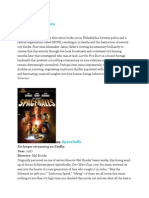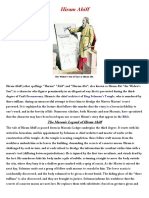Denzel Washington: Notes On The Construction of A Black Matinee Idol
Denzel Washington: Notes On The Construction of A Black Matinee Idol
Uploaded by
Emmanuel MatutuCopyright:
Available Formats
Denzel Washington: Notes On The Construction of A Black Matinee Idol
Denzel Washington: Notes On The Construction of A Black Matinee Idol
Uploaded by
Emmanuel MatutuOriginal Title
Copyright
Available Formats
Share this document
Did you find this document useful?
Is this content inappropriate?
Copyright:
Available Formats
Denzel Washington: Notes On The Construction of A Black Matinee Idol
Denzel Washington: Notes On The Construction of A Black Matinee Idol
Uploaded by
Emmanuel MatutuCopyright:
Available Formats
www.thecine-files.
com
DOSSIER ON FILM PERFORMANCE
Denzel Washington: Notes on the Construction of a Black Matinee Idol
Cynthia Baron
Denzel Washington, with Albert Hall and Brazylia Kotere, in Devil in a Blue Dress (1995).
Donald Bogle describes Denzel Washington as an actor who reconfigured “the concept
of classic movie stardom.”1 His observation suggests that as a consequence of
Washington’s career, Hollywood stardom no longer requires a link with whiteness, but
can now emerge from screen performances that have “liberated black images from the
shackles of ghettocentricity and neominstrelsy.”2 Washington’s body of work, which
includes regular-guy roles in films such as Devil in a Blue Dress (1995), He Got Game
(1998), John Q (2002), and The Taking of Pelham 123 (2009), transcends the
predator-saint categories generated by white norms. As a “star performer,” Washington
has come to embody a residual and alternative vision of black masculinity grounded in
skill and mastery of technique.3 His performances recall the grace and proficiency of
Bill Robinson, a performance mode lifted and popularized by Fred Astaire.4
Washington’s career thus provides a site for interrogating larger questions of identity
and mainstream representation.
Bogle’s observation that Denzel Washington reshaped “classic movie stardom” also
intimates that Washington is best understood as an earlier iteration of romantic leading
man, in part because his characters tend to share emotional, rather than physical
intimacy with female characters. To understand that emphasis, one might recall that
Washington was born in 1954, the year Brown v Board of Education made school
segregation unconstitutional and the year Joseph Breen retired after twenty years as
The Cine-Files 6 (Spring 2014)
2
head of Hollywood’s Production Code Administration. While these events signal
change, the bigotry ingrained in Hollywood conventions, which were and are designed
to preempt objections from vocal constituencies, have meant that Washington has had
the ability, demeanor, and physicality to play leading parts, but that his roles have
rarely included the standard scenes of physical intimacy between the male and female
stars.
Hollywood’s standardized representational and business practices have, arguably,
widened Washington’s appeal, and made him a matinee idol comparable to stars like
Cary Grant. Because love scenes have been generally off limits, Washington’s
portrayals have highlighted the personhood of his characters, who implicitly draw their
talent, strength, and problem-solving strategies from African-American cultural
traditions. Because Hollywood conventions have censored scenes of physical
intimacy, Washington’s performances have revealed his ability to convey emotional
intimacy and thus increased his romantic allure.
With Washington born the year of Brown v Board of Education and the change in
censorship personnel, his image reflects its specific social and institutional context,
which is different from the settings for the careers of Paul Robeson or Sidney Poitier
and from the career of an actor like Jamie Foxx. For example, Washington was in
grade school when Poitier won his Academy Award for Best Actor in 1963. Two
decades later, Washington had received his Best Supporting Actor Oscar for Glory
(1989) before films like Boyz n the Hood (1991) and New Jack City (1991) were even
released. Washington’s theatre work includes an Obie Award in 1982 as a member of
the Negro Ensemble Company’s production of A Soldier’s Play. His career as a screen
actor began in the early 1980s, a time between Blaxploitation and New Black Cinema,
when Eddie Murphy was taking Richard Pryor’s place as Hollywood’s most successful
black comedic actor.
It might seem odd to suggest that representational constraints have shaped
Washington’s star image. He was named “the sexiest man alive” in People magazine’s
1996 survey (Brad Pitt 1995, George Clooney 1997) and “entertainer of the year” by
Entertainment Weekly in 2002 (Nicole Kidman 2001, Lord of the Rings cast 2003). In
polls done by PR firm Harris Interactive, Washington has been identified as one of
America’s top ten favorite actors every year but two since 1995; he was named
America’s favorite star in 2006, 2007, 2008, and 2012, ranking above Clint Eastwood,
Tom Hanks, and Johnny Depp. He has won Black Reel and BET awards, NAACP
Image awards, Golden Globe and film critics’ awards. In addition to his Best Actor
Academy Award for Training Day (2000), he has a Best Supporting Actor nomination
for Cry Freedom (1987), and Best Actor nominations for Malcolm X (1992), The
Hurricane (1999), and Flight (2012).
Yet observers often see Washington’s roles as reflecting the presence of racist norms,
even in cases such as the 1980s St. Elsewhere series or the 1993 Kenneth Branagh
production of Much Ado About Nothing, when Washington’s appearance as the token
black actor is meant to signal a break with traditional casting. Critics also identify racist
norms as the reason films avoid scenes of physical intimacy between Washington and
a white female costar, with the absence of scenes with Julia Roberts in The Pelican
Brief (1993) or with Kelly Lynch in Virtuosity (1995) perhaps the most discussed
instances. Hollywood’s established convention of onscreen segregation makes the
The Cine-Files 6 (Spring 2014)
3
mostly implicit physical intimacy between Washington and Kelly Reilly in Flight a
curiosity; Flight’s oddity is a reminder that “Hollywood’s permissible field of
representation is demonstrated as much by the topics that the industry [has] avoided
as by the images that eventually fill the screen.”5 Although criticized for fostering liberal
values, Hollywood’s “permissible field of representation” and the star image of black
actors like Denzel Washington continue to be shaped by the bigotry molded into
Hollywood conventions.
Washington’s career reflects a specific stage in the ongoing conflicts between Breen-
generated practices and the egalitarian values of the civil rights movement. It also
reflects Washington’s negotiations with those conditions. With his co-starring or
secondary roles in Carbon Copy (1981), A Soldier’s Story (1984), Power (1986), and
Cry Freedom showing that he was a skilled actor, Washington was able to secure the
leading role in The Mighty Quinn (1989). However, with Hollywood practices still
shaped by bigotry, Washington’s first role as a romantic leading man went unnoticed.
The Jamaican detective story earned only $4.5M at the box office. Washington and his
agent had underestimated entrenched practices: MGM did not expand distribution
beyond the opening weekend’s 234 theatres, having determined before the film’s
release that it was suitable only for “ethnic audiences.”6
Washington’s role in For Queen and Country (1988), which put him at the center of the
narrative and made the courtship between his character and a neighbor played by
British actress Amanda Redman central to the story, was another miscalculation on the
part of Washington and his agent. The film made less than $200,000, with Atlantic
Releasing placing it in only 33 theatres. Atlantic’s decision reflects its view that the film
had a limited audience, even though the distributor had developed strategies that
same year to secure a $2.3M box office gross for A World Apart (1988), which focused
on whites battling apartheid.
Washington’s subsequent roles as a romantic lead in Mo’Better Blues (1990) and
Mississippi Masala (1991) were also not marketed to mainstream audiences. Spike
Lee’s film made $16M; Mira Nair’s made $7M. These box office returns confirmed that
Hollywood business practices would continue to be shaped by racist norms, and that
Washington’s romantic portrayals would, as a consequence, reach only a limited
audience. With starring comedic roles going to Eddie Murphy, and parts in urban crime
films going to younger actors, from the 1990s forward Washington appeared primarily
in films that established his association with characters known for their wit,
determination, ethical decency, and ability to share emotional intimacy with colleagues,
friends, and family.
The Pelican Brief was the first of many films that offered that opportunity. With prices
adjusted for inflation, the film remains the top grossing movie in Washington’s career.
Its onscreen segregation of the co-stars also exemplifies Hollywood’s ingrained racist
conventions. As John McWhorter noted at the time: “If Julia Roberts had been
costarred with absolutely any attractive white male working in Hollywood, a romantic
angle would have been assumed [yet] there was America’s black matinée idol . . . on
screen with lovely Julia Roberts . . . and the two of them are ‘friends.’”7 (108). bell
hooks saw the main characters as “completely allied with the existing social structure
of white-supremacist patriarchy” because there was no romance despite Washington
being “‘the black male sex symbol” of the period.8 Those observations are entirely
The Cine-Files 6 (Spring 2014)
4
right, and yet Washington’s performance as the quietly determined reporter also filled
Hollywood screens with an image that did not conform to stereotypes of African
American men as predators, saints, or buffoons.
Denzel Washington in Philadelphia (1993).
That same December, Washington’s co-starring role in Philadelphia (1993) was
another instance when Hollywood strictures on representing black romance helped to
establish Washington as “a regular guy” audiences could identify with and as a classic
movie star. With Hanks portraying the character identified with non-normative
sexuality, Washington became associated with broad-based social and even sexual
norms. His character offered a point of identification for a range of audiences, in that
Washington, who goes from being a close-minded ambulance-chasing lawyer to a
compassionate and effective agent of social change, embodies the film’s narrative arc
in which homophobic beliefs are supplanted by a respect for all individuals’ civil rights.
Denzel Washington in Courage Under Fire (1996).
A few years later, Courage Under Fire (1996) created another occasion when
Hollywood conventions led Washington to become the focus of audience identification.
In the film, Meg Ryan is a medevac pilot posthumously awarded a Medal of Honor.
The film cleverly keeps Ryan and Washington connected, but distant as it traces
Washington’s investigation of events surrounding the crash. With Ryan in the story
about changing gender and social norms, Washington becomes associated with
broad-based values as the film comes to center on the story of Nat Serling, a tank
commander haunted by guilt for covering up a friendly-fire incident he ordered.
Washington’s performance conveys the character’s faltering journey from denial and
The Cine-Files 6 (Spring 2014)
5
isolation to responsibility and reconnection with family. As expected, the black
character’s family life is conveyed briefly, in a series of scenes between Denzel
Washington and Regina Taylor that together last less than ten minutes. Yet despite
Hollywood’s standardized deference to white audiences, the scenes with Washington
and Taylor create a rich narrative about a black married couple’s loss and renewal of
physical and emotional intimacy, and their reunion signals the close of the narrative.
Washington’s performances in films like John Q (2002) and The Taking of Pelham 123
(Scott, 2009) also conform to Hollywood conventions by eliminating the romantic
dimension of the black couple’s relationship. Yet with Washington portraying “a regular
guy,” he again becomes identified with characters that possess the emotional depth
required to face universal ethical dilemmas, and films such as these tacitly make black
family dramas stand in for American family dramas. Thus, despite being designed not
to offend the widest and whitest audience, Washington’s body of work is, arguably,
anchored by a series of portrayals that reconfigure images of black masculinity and
“classic movie stardom.” Although Washington’s heavily censored matinee idol image
is antiquated by 21st century norms, it reflects the specific options, challenges, and
negotiations in Washington’s career. With romance and physical intimacy off limits,
over the course of his career Washington became associated with characters defined
by their grace, dignity, humanity, and inner strength. Thus, in Washington’s case, his
image as a matinee idol and a star known for commitment to family and community
has been constructed, at least in part, by the racism in Hollywood’s conventions and
business practices.
Cynthia Baron teaches in the Department of Theatre and Film and the doctoral
American Cultures Studies Program at Bowling Green State University. She has
recently completed a book on Denzel Washington for the Palgrave Film Stars series.
She is co-author of Reframing Screen Performance (2008) and Appetites and
Anxieties: Food, Film and the Politics of Representation (2014). She is co-editor of
More Than a Method: Trends and Traditions in Contemporary Film Performance
(2004) and editor of The Projector: An Electronic Journal on Film, Media, and Culture.
1 Donald Bogle, Toms, Coons, Mulattoes, Mammies & Bucks: An Interpretive History of Blacks
in American Films 4th edition (New York: Continuum, 2004), 123.
2 Melvin Donalson, “Denzel Washington: A Revisionist Black Masculinity,” in Pretty People:
Movies Stars of the 1990s, ed. Anna Everett (New Brunswick, NJ: Rutgers University Press,
2012), 66.
The Cine-Files 6 (Spring 2014)
6
3 Christine Geraghty, “Re-examining Stardom: Questions of Texts, Bodies and Performance,”
in Reinventing Film Studies, eds. Christine Gledhill and Linda Williams (London: Arnold, 2000),
183-201.
4 For further discussion of these performance modes, see Todd Boyd, The New H.N.I.C (Head
Niggas in Charge): The Death of Civil Rights and the Reign of Hip-Hop (New York: New York
University Press, 2002); Richard Dyer, Heavenly Bodies: Film Stars and Society (London:
British Film Institute, 1986); and Krin Gabbard, Black Magic: White Hollywood and African
American Culture (New Brunswick, NJ: Rutgers University Press, 2004).
5 Ruth Vasey, The World According to Hollywood, 1918-1939 (Madison: The University of
Wisconsin Press, 1997), 12.
6 Douglas Brode, Denzel Washington: His Films and Career (Secaucus, NJ: Carol Publishing,
1997), 73.
7 John H McWhorter, Losing the Race: Self-Sabotage in Black America (New York: The Free
Press, 2000), 108.
8 bell hooks, Reel to Real: Race, Sex, and Class at the Movies (New York: Routledge, 1996,
85).
The Cine-Files 6 (Spring 2014)
You might also like
- Lucrare de AtestatDocument23 pagesLucrare de Atestatfiona25No ratings yet
- Consulting Services, Recruitment & Placement Agencies - 1375Document96 pagesConsulting Services, Recruitment & Placement Agencies - 1375sakar guptaNo ratings yet
- Marilyn Monroe Sex Symbol Film Performance Gender Politics and 1950s Hollywood CelebrityDocument11 pagesMarilyn Monroe Sex Symbol Film Performance Gender Politics and 1950s Hollywood Celebrity麥晞妍No ratings yet
- Transcript - Chadwick BosemanDocument5 pagesTranscript - Chadwick BosemanEmmanuel MatutuNo ratings yet
- Transcript - Wentworth MillerDocument3 pagesTranscript - Wentworth MillerEmmanuel Matutu100% (1)
- White Patriarchal Capatalism EssayDocument8 pagesWhite Patriarchal Capatalism Essayapi-355203086No ratings yet
- George Clooney: The Last Great Movie StarFrom EverandGeorge Clooney: The Last Great Movie StarRating: 1.5 out of 5 stars1.5/5 (4)
- Research Paper Draft 3Document12 pagesResearch Paper Draft 3api-317738172No ratings yet
- Malcolm X ArticleDocument18 pagesMalcolm X ArticledrjNo ratings yet
- Lewis, Horror of Single Mothers in Amenabar's The OthersDocument29 pagesLewis, Horror of Single Mothers in Amenabar's The OthersdiapappNo ratings yet
- Diasporic Film AestheticDocument11 pagesDiasporic Film AestheticAj100% (1)
- John Wayne BiographyDocument23 pagesJohn Wayne BiographyMifta ElfNo ratings yet
- Inner Views: Filmmakers in Conversation: Expanded EditionFrom EverandInner Views: Filmmakers in Conversation: Expanded EditionRating: 3.5 out of 5 stars3.5/5 (2)
- Best Netflix MoviesDocument11 pagesBest Netflix MoviesJennifer SmithNo ratings yet
- A Star Is BornDocument3 pagesA Star Is BorncolsonNo ratings yet
- Hollywood's Gender Diversity Problem: Past, Present, and FutureDocument9 pagesHollywood's Gender Diversity Problem: Past, Present, and FutureCassandra ClarkNo ratings yet
- Masculinity and Changing Gender Roles in Film Dayna VancottDocument6 pagesMasculinity and Changing Gender Roles in Film Dayna Vancottapi-469664485No ratings yet
- Jerrell Mobley Eip-FinalDocument10 pagesJerrell Mobley Eip-Finalapi-340117042No ratings yet
- Lloyd BridgesDocument12 pagesLloyd BridgesAnaNo ratings yet
- Research Paper Final DraftDocument18 pagesResearch Paper Final Draftapi-317738172No ratings yet
- American Rebel: The Life of Clint EastwoodFrom EverandAmerican Rebel: The Life of Clint EastwoodRating: 3.5 out of 5 stars3.5/5 (28)
- William Bradley PittDocument2 pagesWilliam Bradley PittAndrei SlabakovNo ratings yet
- BOOK ABSTRACT - Racial Stigma On The Holl PDFDocument3 pagesBOOK ABSTRACT - Racial Stigma On The Holl PDFImanZanatulHaeriNo ratings yet
- Cynthia Baron and Yannis Tzioumakis - Beyond Indiewood- American Independent Cinema in the Digital AgeDocument15 pagesCynthia Baron and Yannis Tzioumakis - Beyond Indiewood- American Independent Cinema in the Digital Agedoyl4581No ratings yet
- Performance Performativityprofit PDFDocument10 pagesPerformance Performativityprofit PDFMaria LoliNo ratings yet
- Research Paper Draft 2Document8 pagesResearch Paper Draft 2api-317738172No ratings yet
- Brand PittDocument2 pagesBrand Pittanonymous.acc4meNo ratings yet
- Movie Review of "The Great Debaters" With Special Emphasis On Social Constructs in TexasDocument4 pagesMovie Review of "The Great Debaters" With Special Emphasis On Social Constructs in TexasSneha GuptaNo ratings yet
- Cinephile Vol4 Big Part 8Document4 pagesCinephile Vol4 Big Part 8Dewi AsmaraNo ratings yet
- Commented (1) : Revisit Hunger Games Article, NYT: Asian ActorsDocument12 pagesCommented (1) : Revisit Hunger Games Article, NYT: Asian ActorsJoseph J. MervisNo ratings yet
- Howard Hawks: Director, Producer, & ScreenwriterDocument11 pagesHoward Hawks: Director, Producer, & ScreenwriterStakes LuceroNo ratings yet
- Deadpool When Our AntiHeroes Do LessDocument20 pagesDeadpool When Our AntiHeroes Do LessMarius Daugėla100% (1)
- Samuel És Un ParguelaDocument8 pagesSamuel És Un ParguelaCarles AsensiNo ratings yet
- I Know Where You Keep Your Gun''Document18 pagesI Know Where You Keep Your Gun''time_wraithNo ratings yet
- Hstaa 365 Final PapersDocument8 pagesHstaa 365 Final Papersapi-522855390No ratings yet
- Hitch: The Best Black-And-Brown-And-White Movie I Ever Saw: Rotten Tomatoes Averages Hitch's Reviews at 69%Document13 pagesHitch: The Best Black-And-Brown-And-White Movie I Ever Saw: Rotten Tomatoes Averages Hitch's Reviews at 69%Amit BattaNo ratings yet
- Denzel Washington - Actor (PDFDrive)Document129 pagesDenzel Washington - Actor (PDFDrive)Bouta chrysNo ratings yet
- The Big Picture Issue 18Document23 pagesThe Big Picture Issue 18Intellect Books100% (6)
- Action Star ListDocument7 pagesAction Star ListElla Tossan CatsiNo ratings yet
- After All Is Said and Done Once More EliDocument5 pagesAfter All Is Said and Done Once More EliNorman OachsNo ratings yet
- Riley RoosDocument9 pagesRiley Roosapi-355744815No ratings yet
- Brown-GenderActionHeroine-1996Document21 pagesBrown-GenderActionHeroine-1996luyongyanyylNo ratings yet
- Cult Filmmakers: 50 Movie Mavericks You Need to KnowFrom EverandCult Filmmakers: 50 Movie Mavericks You Need to KnowRating: 5 out of 5 stars5/5 (3)
- Top 10 Movies of All TimeDocument28 pagesTop 10 Movies of All Timesemjackson41No ratings yet
- Media Influences PaperDocument6 pagesMedia Influences Papersec0488No ratings yet
- Marxism, Cinema and Some Dialetics of Science Fiction and Film Noir - Carl FrieedmanDocument21 pagesMarxism, Cinema and Some Dialetics of Science Fiction and Film Noir - Carl FrieedmanLuisa LimaNo ratings yet
- Scarface: An Ultraviolet Hit in The Golden Age of HollywoodDocument6 pagesScarface: An Ultraviolet Hit in The Golden Age of HollywoodZach MillerNo ratings yet
- Bruce Willis Filmography - Wikipedia, The Free EncyclopediaDocument5 pagesBruce Willis Filmography - Wikipedia, The Free EncyclopediahawkjohnNo ratings yet
- Samuel JacksonDocument8 pagesSamuel JacksonAmaury Guillermo BaezNo ratings yet
- Alfonso Casta Martinez High School Maunabo, Puerto RicoDocument5 pagesAlfonso Casta Martinez High School Maunabo, Puerto Ricob988g6c9v2No ratings yet
- Thought-Provoking Dramas Have Been A Rare Spectacle in The Last Decade For VariousDocument6 pagesThought-Provoking Dramas Have Been A Rare Spectacle in The Last Decade For Variousapi-666596583No ratings yet
- George ClooneyDocument10 pagesGeorge Clooneytraveleze77No ratings yet
- MbeyaregDocument206 pagesMbeyaregEmmanuel MatutuNo ratings yet
- Machine Element and Design IDocument54 pagesMachine Element and Design IEmmanuel MatutuNo ratings yet
- Automation PLC ScadaDocument14 pagesAutomation PLC ScadaEmmanuel MatutuNo ratings yet
- Final Timetable For Semester Ii Examinations of The Academic Year 2022/2023 TO Students Under Certificate and Diploma ProgrammesDocument45 pagesFinal Timetable For Semester Ii Examinations of The Academic Year 2022/2023 TO Students Under Certificate and Diploma ProgrammesEmmanuel MatutuNo ratings yet
- Machine Element and Design IDocument34 pagesMachine Element and Design IEmmanuel MatutuNo ratings yet
- 1.introduction To PLCDocument47 pages1.introduction To PLCEmmanuel MatutuNo ratings yet
- Nurhilal 2018 J. Phys. Conf. Ser. 1080 012024Document7 pagesNurhilal 2018 J. Phys. Conf. Ser. 1080 012024Emmanuel MatutuNo ratings yet
- Document 3Document5 pagesDocument 3Emmanuel MatutuNo ratings yet
- Unesco - Eolss Sample Chapters: Mechanical EngineeringDocument8 pagesUnesco - Eolss Sample Chapters: Mechanical EngineeringEmmanuel MatutuNo ratings yet
- Diploma AssignmentDocument2 pagesDiploma AssignmentEmmanuel MatutuNo ratings yet
- PRESSUREDocument75 pagesPRESSUREEmmanuel MatutuNo ratings yet
- 1888ConstantinopleConventionon PDFDocument4 pages1888ConstantinopleConventionon PDFEmmanuel MatutuNo ratings yet
- Engineering Encyclopedia: Piping Maintenance and RepairDocument46 pagesEngineering Encyclopedia: Piping Maintenance and RepairEmmanuel MatutuNo ratings yet
- Hiram Abiff 2Document3 pagesHiram Abiff 2Emmanuel MatutuNo ratings yet
- Transcript - Denzel WashingtonDocument4 pagesTranscript - Denzel WashingtonEmmanuel MatutuNo ratings yet
- The Last SupperDocument2 pagesThe Last SupperEmmanuel MatutuNo ratings yet
- Basics of AutomationDocument142 pagesBasics of AutomationEmmanuel MatutuNo ratings yet
- Sandro Botticelli: MasterworksDocument1 pageSandro Botticelli: MasterworksEmmanuel MatutuNo ratings yet
- Who Was Hiram Abiff?: June 2010Document6 pagesWho Was Hiram Abiff?: June 2010Emmanuel MatutuNo ratings yet
- Special Operations Forces (SOF) and CIA Paramilitary Operations: Issues For CongressDocument9 pagesSpecial Operations Forces (SOF) and CIA Paramilitary Operations: Issues For CongressEmmanuel MatutuNo ratings yet
- Allen Dulles Director of Central Intelli PDFDocument1 pageAllen Dulles Director of Central Intelli PDFEmmanuel MatutuNo ratings yet
- Vijaya Collection Shree Maruti Courier Tracking TILL 14-10-2021Document6 pagesVijaya Collection Shree Maruti Courier Tracking TILL 14-10-2021Sneha BhosaleNo ratings yet
- IT chapter 1Document1 pageIT chapter 1Duy Quang LêNo ratings yet
- Web Note Debarred Candidates 080923 120230908211506Document2 pagesWeb Note Debarred Candidates 080923 120230908211506Prep RCNo ratings yet
- 周末电影评分Document6 pages周末电影评分afefjcjue100% (1)
- Northn Zone-Delhi: List of Dic'S OfficesDocument54 pagesNorthn Zone-Delhi: List of Dic'S OfficesvijaiviruNo ratings yet
- New New Members List 2012Document49 pagesNew New Members List 2012US Soy CouncilNo ratings yet
- Peliculas SociopoliticasDocument59 pagesPeliculas SociopoliticasКарлос Ортис КальдеронNo ratings yet
- (.Watch.) Full - Venom 3: The Last Dance (2024) Fullmovie Online On Streamings (Usa01)Document6 pages(.Watch.) Full - Venom 3: The Last Dance (2024) Fullmovie Online On Streamings (Usa01)Nik FareezNo ratings yet
- Phy & ChemDocument5 pagesPhy & ChemLaxman PrasadNo ratings yet
- Devraj - Framing in Films of Wes Anderson - mentor-JAVED KHATRIDocument59 pagesDevraj - Framing in Films of Wes Anderson - mentor-JAVED KHATRILily D'saNo ratings yet
- C C C C C C C CDocument8 pagesC C C C C C C Ctauqeer1983No ratings yet
- R22 Sem 1 CO-PO Attainment Calculation SheetDocument92 pagesR22 Sem 1 CO-PO Attainment Calculation SheetsurendranathNo ratings yet
- Movie Review ADocument19 pagesMovie Review AFarida HamdaliNo ratings yet
- IIT BHU Selected CandidatesDocument8 pagesIIT BHU Selected CandidatesNikhil WaniNo ratings yet
- Download Complete Fantastic Voyages of the Cinematic Imagination Georges Melies s Trip to the Moon Matthew Solomon PDF for All ChaptersDocument81 pagesDownload Complete Fantastic Voyages of the Cinematic Imagination Georges Melies s Trip to the Moon Matthew Solomon PDF for All Chapterspessastarap4100% (2)
- Sec CDocument2 pagesSec CG Prathibha BharadwajNo ratings yet
- SP CinecorpDocument3 pagesSP Cinecorpbcsr2gk2h4No ratings yet
- Sheikh LyricsDocument4 pagesSheikh LyricsanoopNo ratings yet
- Capgemini Shortlsited Students List 2025 BatchDocument70 pagesCapgemini Shortlsited Students List 2025 Batch1655KRISH PUNDIRNo ratings yet
- List-3 29062021Document142 pagesList-3 29062021BSNo ratings yet
- MalaikottaiDocument6 pagesMalaikottaiTeam OsitoNo ratings yet
- Panel - IDocument17 pagesPanel - IVijay KumarNo ratings yet
- Robotics Exel DataDocument5 pagesRobotics Exel DataMukeshNo ratings yet
- LocalDocument6 pagesLocalSanjana SatishNo ratings yet
- GST Dept List PDFDocument21 pagesGST Dept List PDFcogent payrollNo ratings yet
- Tax Bar Association NERDocument12 pagesTax Bar Association NERbgunjan321No ratings yet
- When Husbands Are Victims of Domestic Violence - TOIDocument16 pagesWhen Husbands Are Victims of Domestic Violence - TOIShrikant SomanNo ratings yet
- KOLAR03062024Document16 pagesKOLAR03062024varshithaga3052003No ratings yet
- 15MG Students Data@eceDocument113 pages15MG Students Data@eceHari Krishna MusunooriNo ratings yet
















































































































